Abstract
The presence of macroplastics in the marine ecosystem is one of the most serious types of pollution today. On the seabed of reef ecosystems, macroplastics are an indicator of contamination because they are easily observable due to their size greater than 2.5 cm. When these wastes sink, they cause serious damage, such as physical changes to the seabed, entanglement, ingestion and transport of invasive species, and can serve as vectors for other pollutants. The main types of macroplastics found in this research work correspond to 57% fishing gear, 14% plastic fragments and 9% textiles. Most of the macroplastics were located in the Veracruz reef subsystem, in the Gallega, Anegada de adentro, Ingenieros, Pájaros and Hornos reefs; In the Antón Li-zardo reef subsystem, macroplastics were found in the Anegadilla reef and in the middle. In reference to the concentration of macroplastics at the bottom of the PNSAV, it is possible to point out that the higher the density of the material with respect to seawater, the economic activities carried out near the reefs have a greater influence, both in the distribution and in the classification of macroplastics, compared to the hydrodynamics. Finally, with all these elements, a theoretical model of distribution and concentration of macroplastics in reef bottoms is proposed.
1. Introduction
Plastic is an essential material today, its low production cost compared to others such as metal, coupled with its ability to be light and resistant at the same time, has helped increase its popularity. In contrast, the large number of plastic items that are discarded every day has caused the ability of human beings to manage this type of waste to be exceeded, which is why they end up accumulating in different ecosystems. In most cases, the marine ecosystem is the final destination of plastic waste. This problem has increased worldwide and is currently perceived as one of the most serious problems that threaten the marine ecosystem, especially reef systems [1].
Although it is impossible to determine all the waste in the ocean accurately, it can be said that the amount of plastic present in the water column or deposited on the seabed is greater than on the surface. Bozhko (2019) [2] estimates that only 1% of plastics are floating on the surface.
On the seabed, we can find a wide variety of plastic waste; however, those of great size, called macroplastics, are the starting point of a host of problems that are generated from their entry into the sea. In contrast, the classification of plastic waste according to its size has not yet been standardized; however, some of the most important international organizations in the field of marine pollution, such as the Marine Strategy Framework Directive (MSFD), the United Nations Environment Program (UNEP), the National Oceanic and Atmospheric Administration, NOAA and the Technical Subgroup on Marine Litter [3] have adopted the following scale (Table 1, Figure 1).

Table 1.
Plastic waste classification scale [4].
Table 1.
Plastic waste classification scale [4].
| Type of Waste | Dimension |
|---|---|
| macroplastics | >25 mm |
| mesoplastics | 5 mm–25 mm |
| microplastics | 1 µm–5 mm |
| nanoplastics | 1 nm–1 µm |
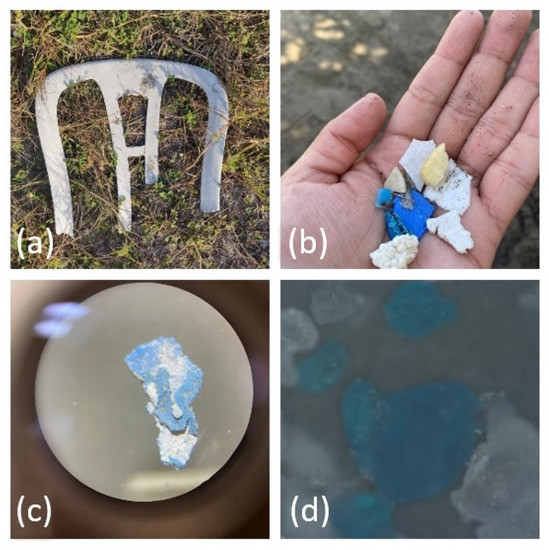
Figure 1.
Classification of plastic waste by size (a) Macroplastics (b) Meso-plastics (c) Microplastics (d) Nanoplastics. Source: [5,6,7].
Worldwide, there are various studies on macroplastics in reef areas. Richards and Beger in 2011 [8] conducted studies on marine litter in the Majuro atoll, Australia, in a 295 km2 lagoon reef close to an area of high population density. In this research they found that the coral cover decreases as the cover of marine debris increases. In 2016 and 2020, Figueroa-Pico et al. [9,10] analyzed marine debris on rocky reefs in Manabí, Ecuador. In this study, 63% of marine debris was associated with fishing activities. Monofilament nets were found on the crests, multifilament lines on the slopes, and plastic containers on the bottom of the reef. Santodomingo et al. in 2021 [11], conducted studies on six inshore reefs east of Sabah, Malaysia. It was reported that 91% of the materials found correspond to plastics; of which ~70% were single-use plastics, ~25% fishing gear. In this study, a relationship was found between the amount of marine litter and proximity to urban centers; marine litter increases in those reefs close to urban centers.
In Mexico, the presence of macroplastics in reef areas was reported in 2020 by Rivera et al. [12], these materials were found in all randomly sampled sites in 21 reef areas, which correspond to Protected Natural Areas (ANP), both in the Gulf of Mexico, Pacific Ocean and Caribbean Sea. All ANPs presented macroplastics both on the surface and in the reef substrate. All the ANPs included in this study are alike in that they have coral reefs close to their coast, for which numerous point sources of pollutant emissions impact them, making them more vulnerable. The area where the greatest number of pieces was found in the reef substrate was in Veracruz, followed by Puerto Morelos and Cozumel.
Compared with other compartments of the marine environment such as the surface, water column, beaches or marine animals, the seabed is the site that has been studied the least; even in shallow areas such as reef systems there are limitations when working in a different environment. Most of the studies carried out in relation to macroplastics in the seabed have focused on identifying their presence, classifying the different types of macroplastics and relating them to some of the factors that influence them in the marine environment. Despite the difficulties involved in trying to find out where a macroplastic comes from and its route to the place where it was found, there are common factors that determine the dynamics of contamination by these plastic materials. The economic activities, the proximity to the mainland, the population density of the communities near the reef areas, the sources of contamination and the hydrodynamics are just some of the factors to take into account.
The Veracruz Reef System National Park (PNSAV) is located in the central part of the reef corridor in the southwest of the Gulf of Mexico off the municipalities of Veracruz, Boca del Río and Antón Lizardo. The port of Veracruz is considered one of the most important tourist destinations in Mexico; in 2021, it presented an influx of one million eight hundred thousand visitors [13]. This municipality has the most important port development in the country, registering a cargo movement of thirty-two million tons in 2021 [14]. The economic interest and industrial development that this region generates encourages population settlement, which does not present a planned arrangement [15,16]. Due to its proximity to the coast, the PNSAV is subject to disturbance and anthropogenic impacts considered to be of a high degree, including contamination by plastic waste [17].
The objective of this study was to evaluate the influence of annual hydrodynamics, pollution sources and economic activities both in the beach area and in the PNSAV polygon, in relation to the concentration, classification and distribution of macroplastics. With this, the origin of the macroplastics found and their possible distribution route in the study area were estimated. The knowledge obtained allowed us to better understand the dynamics of contamination by this type of material in reef areas close to coastal cities.
1.1. Sources of Contamination by Macroplastics
It is estimated that 80% of plastic pollutants in the marine environment come from terrestrial sources of pollution, such as urban runoff and rivers; on the other hand, the remaining 20% corresponds to marine sources, such as industrial activities of gas and oil extraction, fishing and aquaculture [18,19].
It is possible that macroplastics are released into the sea from easily distinguishable sites, called point sources [20]. An example of these is wastewater effluents, whether the final discharge is from a pipe or a canal. In Mexico, this type of discharge is regulated, and a permit is required for this type of effluent [21]; however, these guidelines do not contemplate the presence of plastic waste in said discharges.
Plastic waste can find its way into pipes and canals, carried by wind, rain, floods or thrown directly into sewage discharges by humans. Despite the scant regulation regarding the presence of plastic materials in point sources, its easy monitoring allows maintaining vigilance in order to identify those that emit plastic waste into the sea [22].
On the other hand, there is the possibility that macroplastics are released into the marine environment from diffuse sources of pollution, through several scattered points or in large areas. This makes these types of contamination sources more difficult to locate and, therefore, difficult to monitor and control [22,23,24].
The economic activities carried out on the beaches, especially tourism, generate a significant amount of macroplastics that reaches the sea. In the same way, maritime transport activities or aquatic activities are part of the diffuse pollution that is generated in these areas.
1.2. Concentration of Macroplastics in Bottoms
In addition to the sources of pollution that emit macroplastics directly into the marine environment, other extreme weather events such as storms and hurricanes can cause coastal flooding, increased runoff, and with it, the transport of large volumes of plastic waste to the sea [25]. Once in the marine environment, the dispersal of macroplastics is controlled by waves, ocean currents and winds.
In shallow areas, such as reef ecosystems, the tides are of great importance; since they interact with the characteristics of the coast, such as morphology, coastal vegetation, bioturbation, terrain and slope to transport plastic waste [25]. In the case of macroplastics, a tendency has been observed towards the buoyancy of low-density plastic materials, which is why they remain on the surface for longer periods and travel long distances. On the contrary, high-density plastic materials tend to sink easily and are hardly washed away by masses of water [26].
Some bottles, bags or containers can begin their floating routes influenced by marine currents and be dragged out to sea; however, in most cases when they fill with water, they end up sinking and accumulating on the seabed [2]. In addition to this, there may be plastics with positive buoyancy on the surface of the water presenting growth and adherence of organisms, increasing their density and sinking them. Another possibility is that these residues are ingested by marine organisms and when excreted they sink with the rest of the excrement [27].
1.3. Effects of Macroplastics on Reef Ecosystems
The presence of macroplastics causes havoc from the first moment they come into contact with the environment and the damage can continue to increase for hundreds of years due to their slow degradation [28].
The accumulation of macroplastics decreases the amount of sunlight that reaches the seabed and inhibits gas exchange between the sediment and water interface, generating toxic environments for filter-feeding organisms such as diatoms [29,30]. Organic matter and primary productivity are diminished by abnormal conditions, which have the potential to alter marine communities. Another of the important effects that give rise to changes in the seabed is the colonization of plastic by epifauna, the obstruction of the settlement of several species with a planktonic larval phase and the migration of mobile species attached to these materials [31].
One of the most serious threats to the marine environment is the fishing gear used to capture species of commercial interest, which, when lost or abandoned at sea, continue to capture target and non-target species as they are not under the control of the fishermen [32]. These macroplastics are more common in fishing grounds, and since their losses are most often not reported, it is quite difficult to calculate a precise number. Despite this, estimates suggest that lost or abandoned fishing gear makes up about 10% (640,000 tons) of the world’s marine litter [33].
Ghost gear or other macroplastics sometimes clog or entrap the swimming organs of marine animals, causing entanglement, which commonly results in death by suffocation or drowning [34]. These macroplastics can impair their swimming ability, leading to starvation by reducing food intake efficiency and making it more difficult for them to escape from predators [35]. Added to this, macroplastics can be easily confused by marine animals with their food. When ingested, they can cause internal wounds and ulcers, tearing or perforating the intestinal tract [29,36]. These residues, when ingested, cause an artificial feeling of satiety that can generate malnutrition that can result in death by starvation [37].
Another of the effects caused by macroplastics is coral fracture, which causes the loss of structural complexity of the reefs; due to this, there is a negative correlation between the degree of coral cover and the macroplastic cover [8]. The areas of reef crests and slopes are the most affected since they are structurally more complex than the reef bottom, so it is more likely that fishing gear will become entangled in these areas [10].
Finally, the ingestion of plastics by animals has been proposed as a potential mechanism of the transfer of contaminants that are poorly soluble in water, highly concentrated in plastic particles [38,39,40]. In addition to this, from their normal composition, plastics may contain chemical stabilizers, plasticizers, retardants, residual monomers, which do not allow or delay their degradation under salinity conditions and which are also part of the contaminants that can be transferred [41,42].
1.4. Legal and Social Context of Macroplastics in Mexico
Currently, Mexico does not have federal legislation referring exclusively to the use of plastic materials; however, the country has different guidelines such as the General Law of Ecological Balance, the General Law for the Prevention and Integral Management of Waste [43], the Guide for the Integral Management of Municipal Solid Waste [44] and the Law for the Protection of the Environment in Matters of Environmental Impact Assessment [45]. Regarding the final disposal of solid waste, the legislation is insufficient [46]. However, 13 federal entities have created law initiatives or have approved leyes focused on the regulation of single-use plastics [47,48].
Regarding the implementation of environmental awareness campaigns, a large part of the efforts are made by private institutions, civil associations and international organizations, whose main actions are beach cleaning campaigns and environmental education. In some cases, initiatives for scientific dissemination and environmental education related to the problem of macroplastics are promoted by government institutions and universities; however, the efforts are insufficient when the use of plastic materials continues to increase and when these topics are not included in the official curriculum. Although there is progress in general in that citizens have a greater perception of the impact of plastic waste in the sea, there is still great ignorance and lack of environmental commitment.
2. Materials and Methods
The Veracruz Reef System National Park (PNSAV) is made up of a set of 50 reef structures and has an area of 65,516 ha [49]. This important Protected Natural Area is located in the inner part of the continental shelf in the south-west of the Gulf of Mexico, Frente a las costas de los municipios de Veracruz, Boca del Río y Alvarado. This reef system is geographically divided by the mouth of the Jamapa River into two subsystems: the Veracruz subsystem is to the north of the PNSAV and the Antón Lizardo subsystem to the south. The mouth of the La Antigua River is located to the north of the park and the Papaloapan River to the south [50].
The identification of the point sources was carried out through routes in which the drains that flow directly to the beaches of the Veracruz-Boca del Río metropolitan area were geolocated. The route taken was delimited by the beach area that is located within the main tourist corridor of the state of Veracruz [13], it covers 15.5 km from the Dock of the Navy of Mexico to the Boca Forum (Figure 2). The plastic waste observed, the number of garbage deposits and the main economic activities in the beach area, that are carried out were recorded during the tour, this information was grouped by zones.
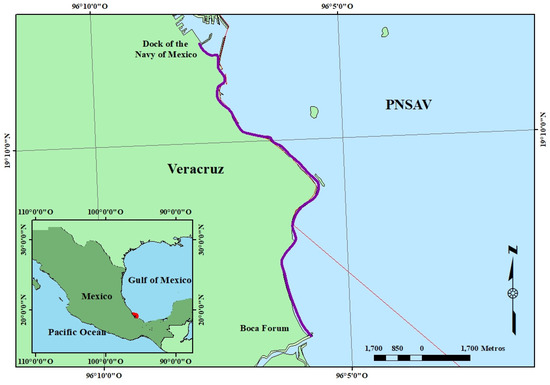
Figure 2.
Route of the tour carried out on the beaches of Veracruz-Boca del Río to identify point sources of contamination.
A bibliographic review was carried out on the records of marine currents in the PNSAV during the months in which the samplings were carried out [51,52]. The speed and direction of the surface current were calculated, adding 15° clockwise to add the twist caused by the Coriolis effect. Subsequently, the distance traveled by the macroplastic from the surface to the depth at which it was found was calculated in order to trace the route that the macroplastic possible followed.
Sampling was carried out in 14 PNSAV reefs (Table 2, Figure 3), during the dry season (May, 2022), rainy season (June–July, 2022) and north wind season (October 2022). For the selection of the reefs, their geographical distribution was taken into account, reefs from the north and south zone of the PNSAV were selected, close to the coast, at a midpoint and far away. Another aspect taken into account were the reports of reefs that present accumulation of macroplastics, by the divers surveyed. Finally, the risk assessment of loss of environmental services carried out by Ortíz-Lozano et al. (2015) [53] was consulted to identify the status of the selected reefs.

Table 2.
Sampling points.

Figure 3.
Location of macroplastic sampling points on the bottom of the Veracruz Reef System National Park (PNSAV).
The sampling was carried out through SCUBA diving. The route always began in the deepest area close to the point of descent, the course was oriented following the geographical configuration of the reef, ascending in a zigzag towards the surface. Both the main diver and the support diver collected the macroplastic pieces that could be removed, the large pieces or those that would affect the reef as a result of their removal were photographed for their subsequent classification by direct observation.
To analyze the influence of hydrodynamics on the plastic objects found in this study, 6 macroplastics were selected that met the characteristic of being less than 1 m in length, which increases the probability that currents will carry them away; the type of plastic that is commonly found are those made with materials with a density greater than that of seawater, which guarantees its sinking. They are made up of one or two types of plastic, which allows obtaining its own characteristics in the density of the macroplastic and therefore the estimates are closer to reality. Finally, macroplastics that were not entangled in corals or attached to structures were chosen since these plastics have little chance of traveling with ocean currents.
Subsequently, a bibliographical review was carried out on the records of marine currents in the PNSAV during the months in which the samplings were carried out. From the calculation of the speed and direction of the surface current, proposed by Riveron-Enzastiga et al. (2016) [51], 15° were added clockwise to add the twist caused by the Coriolis effect. Subsequently, the depth of each marine current was identified, depending on the month in which the macroplastic was found, following the temperature time series contour graphs proposed by Salas-Monreal et al. (2022) [52].
Through a literature review, the density of the material with which the macroplastic was possibly composed was corroborated and multiplied by the volume of the object to obtain its mass. With these data, the precipitation rate for each macroplastic was obtained. To this was added the velocity of each current layer and the resulting velocity was multiplied by the depth of the layer. The calculations carried out allowed an approximation of the distance traveled by the macroplastic from the surface to the depth at which it was found and thus trace the route that the macroplastic possibly followed.
3. Results
3.1. Pollution Sources and Economic Activities in the Veracruz-Boca del Río Beach Area
Of the total number of point sources located in the beach area, 63% correspond to storm drains, 35% to pipes and 3% to point sources whose origin could not be identified (Figure 4).
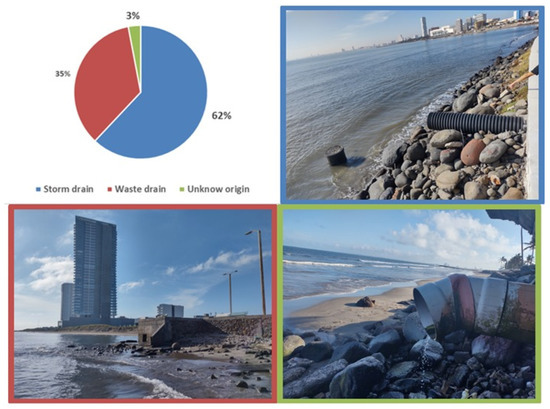
Figure 4.
Point sources of pollution in the Veracruz-Boca del Río beach area.
The main economic activities were tourism, trade and food services, which are present in all areas (Figure 5). In zone 1, 2 and 5, fishing and maritime transport activities are also carried out, despite the fact that there are buildings in all zones; in zone 4, a greater presence of macroplastics related to this activity was observed.
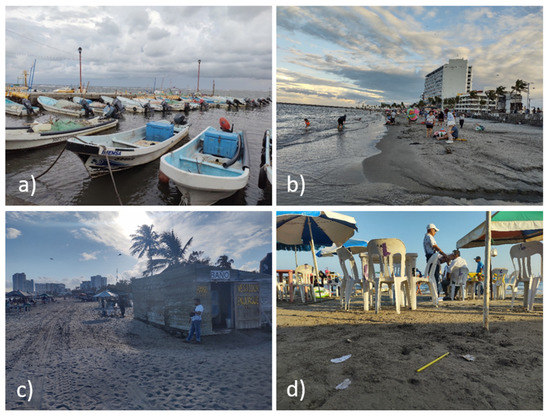
Figure 5.
Main economic activities on the beaches of Veracruz-Boca del Río (a) Fishing and maritime transport, (b) Tourism, (c) Commerce and (d) Food services.
Among the macroplastics found in the different areas, lids, bottles, wrappers and disposable Styrofoam stand out as being the most abundant (Table 3). The fragments of fishing gear were a common element, even in areas where fishing activities are not carried out. Face masks are items that are related to the COVID-19 pandemic, so it is common to find them in these crowded areas.

Table 3.
Sources of contamination on Veracruz-Boca del Río beaches.
Ninety garbage deposits were identified in the study area; on average, each garbage deposit covers approximately 172 m of beach.
3.2. Concentration, Distribution and Classification of Macroplastics in the Bottom of the PNSAV
In this study, a total of 21 macroplastics were reported on the seabed of the PNSAV, of which 17 were recovered and 4 were photographed (Table 4, Appendix A).

Table 4.
Macroplastics found at the bottom of the PNSAV.
Of the macroplastics found, 55% of them possibly correspond to Nylon and the rest of the macroplastics possibly to polypropylene, PVC, polyester, low-density polyethylene and acrylic, all in a proportion of 9%. A total of 19 of the 21 macroplastics found presented biofouling (Figure 6).
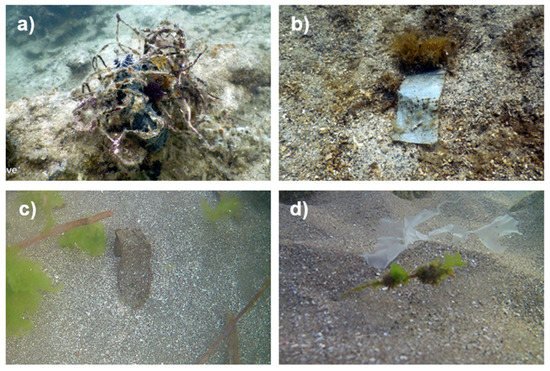
Figure 6.
Macroplastics with biofouling. (a) Fishing net (b) Industrial tape (c) Fragment of film and (d) Fishing line.
In the present study, a greater number of macroplastics is reported in the Veracruz subsystem with 18 objects, unlike the 3 plastic objects found in the Antín Lizardo subsystem (Figure 7).
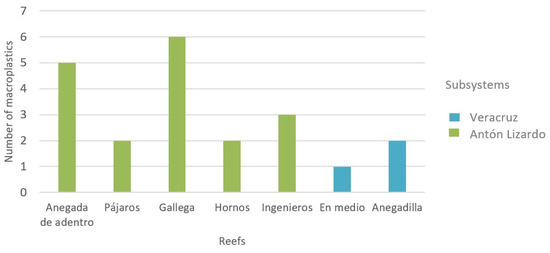
Figure 7.
Distribution of macroplastics in the bottom of the PNSAV.
Of the microplastics found at the bottom of the PNSAV, 57% (12 macroplastics) are related to fishing gear since nets, monofilaments, longlines and grampins were found. The fragments were defined as plastic pieces visible to the human eye that, due to their level of degradation, it is not possible to determine their shape or function [12]. This type of macroplastic was the second most common in the present study, comprising 14% (3 macroplastics). In third place are the synthetic textile fragments in 9% (2 macroplastics) (Figure 8).
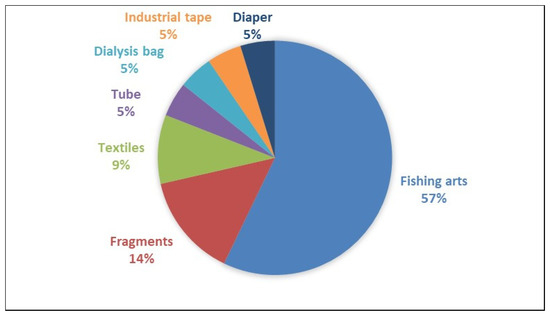
Figure 8.
Types of macroplastics reported in all sampling sites.
3.3. Distribution of Macroplastics in Relation to the Influence of the Annual Hydrodynamics of the PNSAV
The macroplastics selected for the estimation of the possible distribution routes in the PNSAV are shown below (Table 5).

Table 5.
Velocity of precipitation of macroplastics with hydrodynamic influence.
The En medio reef was sampled during the dry season and is part of the Antón Lizardo reef subsystem of the PNSAV. An 18 cm nylon fishing line (ID: 1a) was found on this reef at a depth of 18 m. When calculating the route that this macro-plastic possibly made, it can be seen that the site from which it was emitted was located northwest of the Enmedio reef, near the anchorage area (Figure 9). In the anchorage area, boat transit sets sail from the fishing cooperatives located in the cause of the Jamapa River, in the direction of the Antón Lizardo reef subsystem south of the PNSAV, for which it is very likely to find this type of macroplastics in the area. Another important aspect to mention is that this fishing line was found in a reef lagoon 18 m deep. In this area, there is a low level of water exchange at depths below the reef crest [53]. Therefore, it is very likely that this fishing line, once deposited in the reef lagoon, can travel to other areas with marine currents.
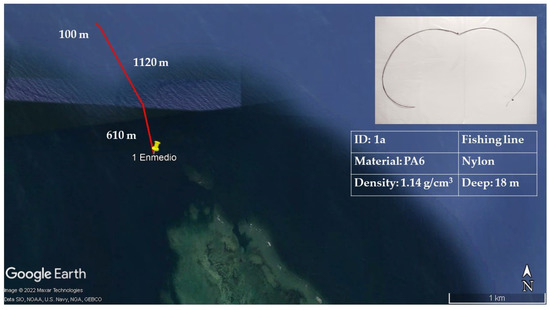
Figure 9.
Simulation of the dispersal route of the macroplastic ID: 1a.
The Pájaros reef is part of the Veracruz reef subsystem and was sampled in the rainy season. At this sampling point, a fragment of what appears to be a beach was found (ID: 8a); this macroplastic was found half-buried on the bare seabed at a depth of 11 m. According to the route that it possibly made, it is very likely that this object comes from the northeast area of the reef; in this area, the presence of tourists who make tours in motorized boats is very common (Figure 10).
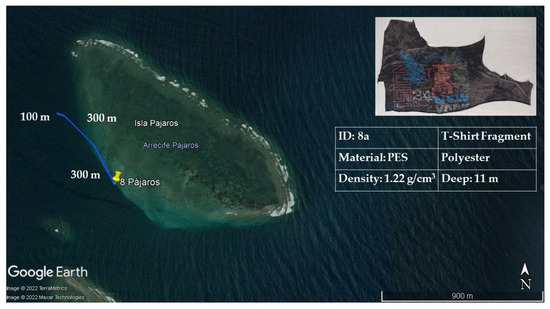
Figure 10.
Simulation of the macroplastic distribution route ID: 8a.
Since a macroplastic of this type is made of a polymer with a higher density than seawater, it sinks faster, so ocean currents have a reduced effect on it. On the other hand, in the area where the beach fragment was found, no large reef structures are observed according to the bathymetry of the area [52], which reinforces the proposed route. Possibly this macroplastic when it hit bottom was covered with sediment and this prevented it from continuing to travel on the seabed, the amount of sediment found on this object and the presence of biofouling allow us to affirm that this macroplastic was already trapped in the sediment for a long time.
From the Gallega reef it was possible to recover a rigid macroplastic, due to its characteristics it was called a fragment of acrylic table (ID: 9a). According to the direction of the marine currents for the month of June [51], it is likely that this object was emitted to the southeast of where it was found. However, this area has a large number of coral patches, being part of the outer reef; so it is likely that the route has been modified by these reef structures (Figure 11). This reef is located right in front of the port area, so this macroplastic can be the product of the activities carried out within the port area or, emitted into the marine environment from one of the ships that sail through the area.
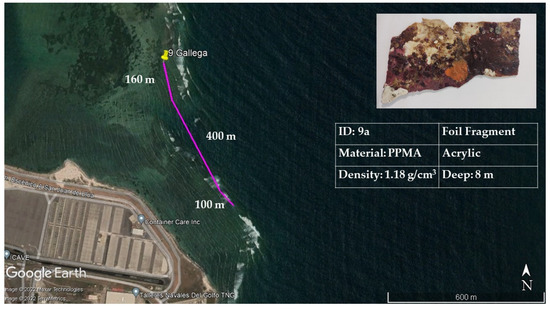
Figure 11.
Simulation of the macroplastic distribution route ID: 9a.
In the Hornos reef, at a depth of 2 m, a textile fragment was recovered from which it was not possible to identify what garment it came from; this fragment was half-buried in the sediment and had biofouling. This object was found in the area between the inner reef and the breakwater of the Pescadores Wall. The estimated trajectory for this macroplastic is directed towards the southeast of the inner reef. It is possible that the rains transported this object towards the sea and that due to its density it is difficult for it to rise with the sea currents and cross the reef crest. By remaining limited to one area, sedimentation could have buried this object and over time promoted biofouling (Figure 12).
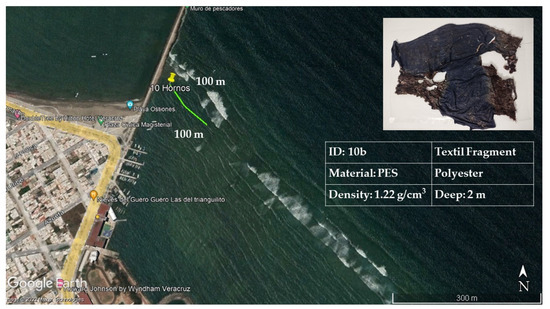
Figure 12.
Simulation of the macroplastic distribution route ID: 10b.
A rigid fragment (11b) with characteristics similar to acrylic was recovered at a depth of 1 m in the Ingenieros reef, during the rainy season. This macro-plastic was found covered with calcareous algae, so it is estimated that a long time has passed in the middle. The proposed route for this object places the possible emission point to the east, on the seabed before the inner reef. This area presents a great hydrodynamism produced by the waves, the decrease and rise of the sea level during tidal events, coupled with the presence in the beach area of macroplastics related to construction. These elements allow us to relate the fragment with characteristics similar to acrylic as a possible waste generated by construction activities in the area, which could have been washed away by the rains and when the tide rose the waves transported it to the sea (Figure 13).
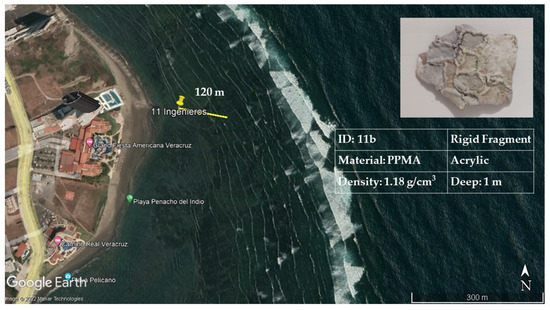
Figure 13.
Simulation of the macroplastic distribution route ID: 11b.
Finally, the route was traced from where the fishing line (ID: 11c) found in the Ingenieros reef, during the rainy season, was possibly emitted. This route places said macroplastic to the east of the possible emission point, on the seabed before the inner reef. However, being a thin and small object, it could have crossed the reef crest as it is an area with great hydrodynamism produced by waves, the decrease and rise of sea level during tidal events. The Ingenieros reef is close to the mouth of the Jamapa river, from where fishing boats head towards the reefs of the Veracruz subsystem and pass in front of this reef, so these factors may be responsible for the presence of this macroplastic (Figure 14).

Figure 14.
Simulation of the macroplastic distribution route ID: 11c.
3.4. Dynamics of the Distribution and Concentration of Macroplastics in Reef Bottoms
The different types of macroplastics are related to the economic activities that are carried out from the point where they are deposited on the seabed to the coast. Reefs near the coasts will present more frequently macroplastics related to economic activities carried out on land; reefs far from the coasts will present a greater number of macroplastics related to activities carried out near the reefs (Figure 15).
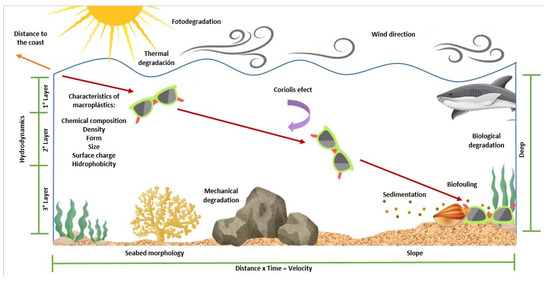
Figure 15.
Factors that influence the distribution and concentration of macroplastics in reef bottoms.
The concentration of macroplastics at the bottom of the reef ecosystem is related to the shape of the object and its size, the more elongated, flattened and large shapes tending to sink more easily than globular, irregular or small shapes. On the other hand, the density and chemical composition of the polymers with which the macroplastics were made influences their sinking potential. Macroplastics with a density less than seawater remain on the surface for longer periods and travel great distances; on the contrary, those with a density greater than that of the sea tend to sink easily and are hardly dragged by sea currents. In addition to this, hydrophobicity determines the speed with which a material absorbs water, which will add weight to the macroplastic. Finally, the ease with which a macroplastic sinks is related to the surface load, given by the load that the seawater surface is capable of withstanding before an object sinks.
Once the macroplastics begin to sink, they are dragged by the surface current, which is directly related to the direction and speed of the wind. Subsequently, when the first layer of marine currents passes, the macro-plastics rotate 15º clockwise due to the Coriolis effect. The number of layers of sea currents that they will cross depends on the depth of the area and the interaction they may have with fauna or with humans, whether this interaction changes their direction when they are transported or pushed towards another site, or that it be removed from the marine environment. In addition to this, the slope of the land and its morphology can slow down the path of a macroplastic in the ocean current.
Other factors such as biofouling, mechanical, thermal, biological degradation and photodegradation influence in such a way that they make plastics with a density less than that of seawater sink. Once on the seafloor, the macroplastics could be washed over the seafloor to stop with some reef structure, rocks or some man-made construction. It is also possible that macroplastics are colonized by organisms in such a way that they become part of the reef landscape or that they are gradually buried due to sedimentation.
4. Discussion
4.1. Distribution of Macroplastics in Relation to the Main Economic Activities and Sources of Pollution in the Coastal and Reef zone
Since the PNSAV is located in a coastal area close to one of the main urban settlements in the state of Veracruz, it is potentially more prone to the impacts of macroplastics due to its proximity to the main sources of land and marine pollution [54]. In addition to this, there is a possibility that the composition of macroplastics in the marine ecosystem is very similar to the waste generated near urban coastal areas [55].
It is important to point out the contribution of storm drains as a source of pollution, which is estimated to be 80% of plastics, three-quarters of the waste that reaches the sea comes from land sources [18,19,56,57]. An important fraction of the plastic waste found in the streets of the city of Veracruz is carried by the winds and accumulates in different parts of the city; later, in the rainy season, this waste travels to the storm sewer network, which sends them directly to the sea [58]. This contribution of contaminants could be confirmed by observing the presence of plastic waste in some drains, especially large ones. Once in the sea, plastic waste is transported by marine currents towards the Veracruz Reef System, causing serious damage to this important ecosystem at all times.
Regarding point sources of contamination, residual discharges do not commonly contain macroplastics since during the treatment of this type of water, large solid waste, whether suspended or floating, is the first to be removed during the treatment process. Primary treatment [59]. However, as in the case of storm drains, it is possible that at some point in the sewage network there are ruptures or cracks through which macroplastics can enter and reach the sea.
In the PNSAV, fishing and tourism are predominant economic activities both in the beach area and in the reefs; due to this, most of the reported macro-plastics are related to said activities. However, macroplastics corresponding to research activities were collected, which were not directly observed in the beach area. On the one hand, as it is a protected natural area of great importance in the Gulf of Mexico, it is very common for various activities to be carried out investigations directly on the reefs. On the other hand, economic activities related to food service are very common in the beach area, however, most of the macroplastics generated by these activities are disposable items, such as Styrofoam containers, plastic bags or wrappers, so they hardly sink.
In the present study, a greater number of macroplastics is reported in the Veracruz subsystem with 18 objects, unlike the 3 plastic objects found in the Antón Lizardo subsystem. The greater amount of plastic waste observed in the Veracruz subsystem may be related to a greater influence of the waters coming from the Jamapa River, the lower hydrodynamism in the north of the PNSAV since it presents lower current speeds than in the reefs of the south [50,51,60] and the largest number of pollution sources located both in the beach area and in the reefs. All this justifies the higher concentrations of macroplastics found in the Veracruz subsystem.
In the northern subsystem, the reef structures are closer to the coast, which could contribute to making them more prone to human disturbances, such as the emission of plastic pollutants [61,62,63]. In 2018, Jiménez-Badillo et al. pointed out that the reefs located in the Antón Lizardo subsystem concentrated the greatest fishing activity, in which 86% of the catches were extracted, while in the reefs of the Antón Lizardo subsystem, only 13% of the total catch [64]. These data differ from those reported by CONANP for 2010, which states that most of the fishing activities in the PNSAV are carried out in the reef structures or in nearby areas of the northern subsystem [65].
Flores-Vargas in 2022 [66], took samples from 3 PNSAV reefs, with the Verde reef being the one with the highest number of microplastics with 5 microplastics/100 g of sediment, followed by the Sacrificios and Ingenieros reef with 3 microplastics/100 g sediment. In the present study, the Anegada de adentro reef was sampled, being the second reef with the highest number of macroplastics reported. This reef is located in the furthest zone within the PNSAV, approximately 2 km from the Verde reef sampled by Flores-Vargas; therefore, it is possible to affirm that there is an increase in the presence of plastic contaminants in this zone compared to reefs within the middle zone of the PNSAV such as the Pájaros y Sacrificios reef, or in the area near the coast, such as the Ingenieros reef.
Although some authors affirm that the majority of the macroplastics present in the marine environment derive from terrestrial sources of contamination. In this study, the macroplastics found at the bottom of the PNSAV are mostly related to sources of aquatic contamination, especially fishing, since 57% (12 macroplastics) of the macroplastics found correspond to nets, monofilaments, longlines and grampins. The aforementioned is possible due to the fact that the Gallega, Anegada de adentro, Anegadilla and En medio reefs, in which the ghost fishing gear was found, according to the PNSAV Management Program, are part of the Sustainable Use subzone of Natural Resources Fishing, which includes a polygon with an area of 61,224.436317 hectares [67].
Within the group of reefs where fishing gear was found, the Gallega reef stands out, which is located north of the PNSAV, close to the port area. Fishing is the main economic activity carried out [68]. In this reef the largest amount of fishing lines was found (5 macroplastics). Because these macroplastics hardly travel with ocean currents by becoming entangled in rocky structures or reefs, it is very likely that they are emitted from points very close to where they were found.
The macroplastics called fragments were those plastic pieces visible to the human eye that, due to their level of degradation, it was not possible to determine their shape or functio [12]. This type of macroplastic was the second most common in the present study, which was 14% (3 macroplastics) of the residues found; despite the fact that other studies have reported large amounts of plastic fragments in reef areas [12].
Regarding the presence of synthetic textile fragments (9%, 2 macroplastics), in the Hornos reef, it is very likely related to tourist activity on the beaches of the municipality of Veracruz, since this reef is part of Polygon 2 of the Subzone for Public Use-Beach Activities-Coastal Recreational Activities [67]. On the other hand, in the Pájaros reef there is a sandy shoal known as Cancuncito, which has a large influx of tourists, which is located within Polygon 1 of the Subzone for Public Use—Destinations for Tours in Motorized Vessels [67,68].
Both the serum bag (5%, 1 macroplastic) and the PVC tube (5%, 1 macroplastic) were related to research activities of university institutions in the coastal zone. These macroplastics were found in the Anegada de Adentro reef, a site that is part of polygon 1 of the Autonomous Diving Public Use Subzone (DOF, 2017) [67].
The fragment of industrial tape (5%, 1 macroplastic) is possibly associated with maritime transport or tourism activities that carry out tours in the Pájaros reef or in surrounding areas [68]. The diaper fragment found in the Hornos reef, as it presents an advanced state of fragmentation, may be more difficult to relate to any particular area; however, throughout the beach area, it is common to see this type of plastic waste.
4.2. Concentration of Macroplastics in Relation to Density, Shape, Size and Presence of Biofouling
The buoyancy of a plastic object in the marine environment is related to the density of the material and its volume. However, the density value of the material can only be used as an initial reference for its behavior, since this value will be modified over time due to degradation and interaction with marine organisms [66].
Other relevant characteristics such as the ability of materials to absorb or repel water that influence the time it takes for a macroplastic to reach the seabed. In addition to this, those characteristics that allow plastics to retard degradation influence both their buoyancy and their distribution within reef ecosystems. Despite not having carried out an analysis to confirm the materials with which the macroplastics found were made, a bibliographical investigation was carried out to find out which objects are made with each type of plastic. It is important to identify the different characteristics of each type of plastic, since it allows us to understand its behavior in the marine environment and from this, an inference will be made about the influence that the type of material has on the dispersion and distribution of the macroplastics in the bottom of the PNSAV; in addition to being able to indicate the possible sources [69].
From a total of 22 macroplastics, 55% (12 macroplastics) of the macroplastics collected correspond to fishing gear commonly made from nylon (PA6), a material whose density (1.14 g/cm3) is higher than that of seawater (1.027 g/cm3), which favors its collapse [70]. These nets and monofilaments are tied to sinkers or hooks that get stuck in rocks or corals and due to their length, they get entangled easily.
The rest of the materials were found in the same proportion (9%) (2 macroplastics). Polypropylene PP is one of the most widely used plastic materials [71]. In the case of disposable diapers, this material is usually used due to its low moisture absorption and its lightness, making it a very useful material for this type of products; however, in the marine environment, being one of the plastics with the lowest density, it can travel long distances with the current and its resistance to water means that it does not degrade easily. It is possible that the fragment of diaper found in Hornos reef has suffered mechanical degradation when getting stuck in rocks or corals, which would contribute to the sediments adhering to this object and when fragmenting these would sink.
PVC is a material widely used in construction; for this study, it was possible to identify that the source of the PVC pipe found in the Anega reef inside corresponds to structures built for scientific purposes, in which this material was used due to its resistance to corrosion and its lightness due to its low density (1.13–1.14 g/cm3) compared to other construction materials such as steel (7.8 g/cm3) or concrete (2.4 g/cm3) [72]. However, these structures, being constantly impacted by the action of the waves, fragment. These fragments, having a density higher than seawater, sink easily and, having hollow spaces, are colonized by various organisms. Medical applications are another common use of PVC; in the Anegada reef, a serum bag was recovered that is consistent with the scientific activity of the area.
Although there are many possible variants of polyester, the best known is the thermoplastic called polyethylene terephthalate (PET). This material has a higher density than seawater (1.22 g/cm3), so it sinks easily; however, the low rate of water absorption inside the fibers allows it to be more durable [73]. Polyester is one of the most used materials in the manufacture of textile fibers since it has a series of properties such as abrasion, discoloration and UVA rays, which means that garments made from this material do not fragment easily.
Low-density polyethylene PEBD (0.91–0.94 g/cm3) is a very light material that tends to float in seawater. However, one of the macroplastics found during the study, a piece of industrial tape commonly made from this material, was colonized by algae, which most likely contributed to its sinking; on the other hand, a fragment of the film was partially recovered from the seabed. PEBD is widely used to manufacture emlaye films; it is very likely that this elongated macroplastic has gotten stuck in the rocks and the accumulation of sediments has submerged it. This material has good impact resistance but is susceptible to stress cracking [70], which makes it prone to fragmenting due to waves. The PEBD It is not very resistant to UV rays and heat, but on the other hand, it has a very low water absorption; due to this, this material has a greater possibility of fragmenting on the surface than on the seabed. There are studies that state that less weathered microplastics retain a density similar to the original material from which they were manufactured, which is why one would expect to find them suspended in the water column [74]. However, over time, physical and microbial degradation can increase the density of the particles, which tend to precipitate and settle [26,75]. These conditions can be applied to macroplastics exposed to similar degradation processes.
Two macroplastics with characteristics similar to polymethylmethacrylate (PPMA) were found in this studio. Two macroplastics with characteristics similar to polymethylmethacrylate were found. PPMA has a low weight due to its low density (1.18 g/cm3) compared to glass (2.53 g/cm3) by which it is replaced due to its high impact resistance. In the marine environment, these macroplastics sink easily since they are denser than seawater. (1.027 g/cm3). Due to the difficulty of mechanical degradation of these materials, it is possible that they entered the environment in the form of fragments of a similar size to the one found. In addition, the fact that one of the fragments that is possibly made of PPMA presents a high amount of biofouling allows us to ensure that it has spent a long period on the seabe. It is important to note that this material is not among the types of plastics commonly found in the marine environment [39,76]; however, its presence may be related to the use of this type of plastic as a construction material in areas close to reefs.
In 2020, Oliveira-Castro et al. [77], analyzed the bottom sediments of two inlets in Niterói, Brazil. In this study, the most common plastics in fragments were polyethylene (PE), polypropylene (PP) and polyamide (PA6); in films they were PE, PP and in fibers they were PE, PP, PA6. The polymers reported in this work coincide in that the films were associated with low-density polyethylene (PE-LD) and fibers were associated with polyester (PES); in the case of the fragments, these were associated with Polymethylmethacrylate (PPMA), unlike the study by Oliveira-Castro et al.
Flores-Vargas in 2022 [66], reported the presence of microplastics on beaches and bottom sediments of the PNSAV; in said study, various polymers were identified: the most abundant polymer was polyester (PES) (47%), followed by semi-synthetic polymer cellophane (9%), polypropylene (PP) and polyacrylonitrile (PAN), which were found in the same proportion (8% each), followed by nylon (5%), polystyrene (PS) (4%) and polyvinyl chloride (PVC) (1%). Coincidences were found in some polymers associated with macroplastics reported in this work, such as PP and PVC.
Another factor to take into account in the concentration of macroplastics in the seabed is the colonization of organisms on the surface of the plastics. It is expected that an object made of plastic with a density less than seawater will float; however, biofouling is one of the main causes of sinking as they add extra weight. Likewise, biofouling is limited by the surface, so smaller items with elongated, flattened, or complex shapes sink more easily [78,79]. Most of the macroplastics reported by this study present biofouling.
Much of the fishing lines and nets identified in this study that were entangled in corals were colonized by organisms such as sponges, corals, and algae [12]. This could be a potential risk for species that feed or take refuge in these areas since these species may suffer from entanglements due to ghost fishing [10,33,34].
Textile fragments were also observed in areas with high sedimentation, such as Hornos and Pájaros Reef. In said macroplastics, a dark film typical of anaerobic environments was formed. Regarding this, an increase in bacterial and algal abundance has been verified in places where the presence of plastics is reported, which has a wide range of negative effects on the ecosystem [80]. In addition, a fragment of film with biofouling was found, which could have contributed to its sinking, trapping it in the sediment, which continued to accumulate on this macroplastic [18].
When contrasting the 7813 tons of urban solid waste generated in Veracruz, of which 13.6% corresponds to plastic waste [81], with the 525 plastic waste found in total on beaches in the municipalities of Veracruz, Boca del Río and Antón Lizardo by López-Hernández (2018) [82]. In turn, when comparing them with the 21 macroplastics reported in this research work, we can affirm that the concentration of macroplastics on the seabed of the PNSAV is much lower than on beaches according to the volumes of waste generated.
5. Conclusions
In this study it was shown that the classification of macroplastics in the reef bottom is influenced mainly by the anthropogenic activities that take place in the reef zone. The distribution and concentration of macroplastics is affected by the hydrodynamics of the Veracruz Reef System National Park (PNSAV), which varies depending on the season of the yea. Based on the results obtained, it is concluded that:
- (1)
- 63% of the sources of contamination present in the Veracruz-Boca del Río beach area correspond to storm drains, 35% to pipes and 3% to point sources whose origin could not be identified.
- (2)
- The concentration of macroplastics at the bottom of the marine ecosystem is related to the shape, size and density of the plastic.
- (3)
- 57% of the macroplastics found in this study correspond to fishing gear, plastic fragments correspond to the second largest group of waste found with 14% and the third group corresponds to textiles with 9%.
- (4)
- Most of the macroplastics were found distributed in the reefs of the Veracruz subsystem, in the Gallega (6 objects), Anegada de adentro (5 objects), Ingenieros (3 objects), Pájaros (1 object) and Hornos (1 objects) reefs; On the other hand, in the reefs of the Antón Lizardo subsystem, only plastics were found in the Anegadilla (2 objects) and Enmedio (1 object) reefs.
- (5)
- Regarding the concentration of macroplastics in the reef bottom, the higher the density of macroplastics with respect to seawater, the economic activities carried out near the reefs have a greater influence compared to hydrodynamics. Contrary to what happens with macroplastics with a density lower than seawater, in this case hydrodynamics has a greater influence compared to economic activities.
Author Contributions
Conceptualization C.M.J. and F.L.R.; methodology, C.M.J., F.L.R. and M.d.R.C.C.; formal analysis, C.M.J. and G.N.R.; investigation, C.M.J., M.d.R.C.C. and F.L.R.; data curation, C.M.J. and G.N.R.; writing—original draft preparation, C.M.J. and F.L.R.; writing—review and editing, C.M.J., F.L.R. and M.d.R.C.C.; discussion of results and contribution to final manuscript; F.L.R. and M.d.R.C.C. All authors have read and agreed to the published version of the manuscript.
Funding
This research was funded by Tecnologico Nacional de México, grant number 15028.22-P.
Institutional Review Board Statement
Not applicable.
Informed Consent Statement
Not applicable.
Data Availability Statement
Not applicable.
Acknowledgments
We thank the Tecnologico Nacional de México (TecNM) for financing the project 15028.22-P Microplastics in turtle nests and the beaches of Nautla, Veracruz.
Conflicts of Interest
The authors declare no conflict of interest.
Appendix A
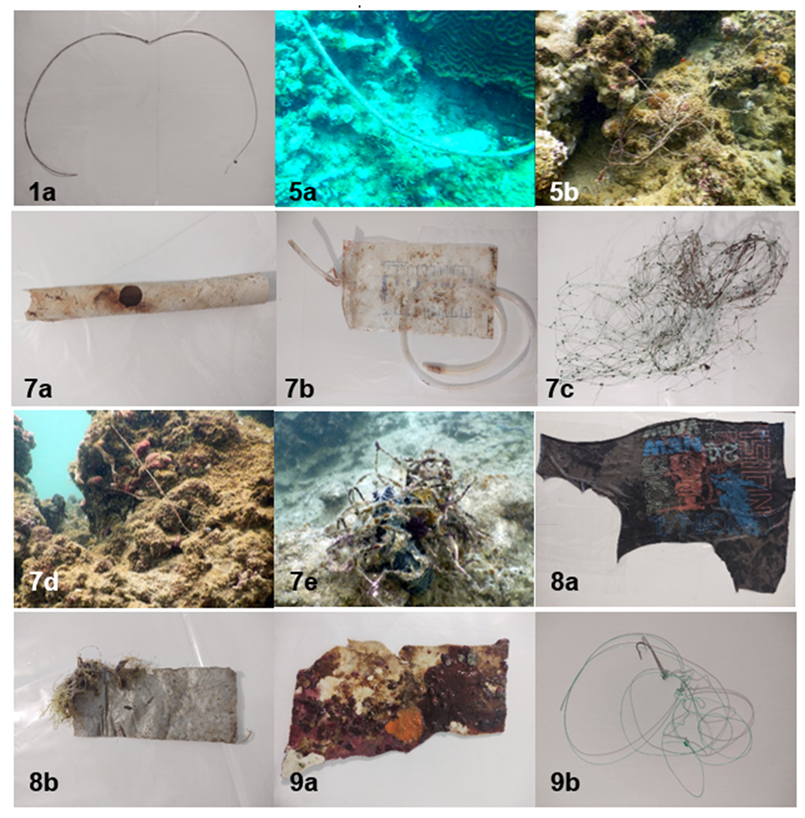
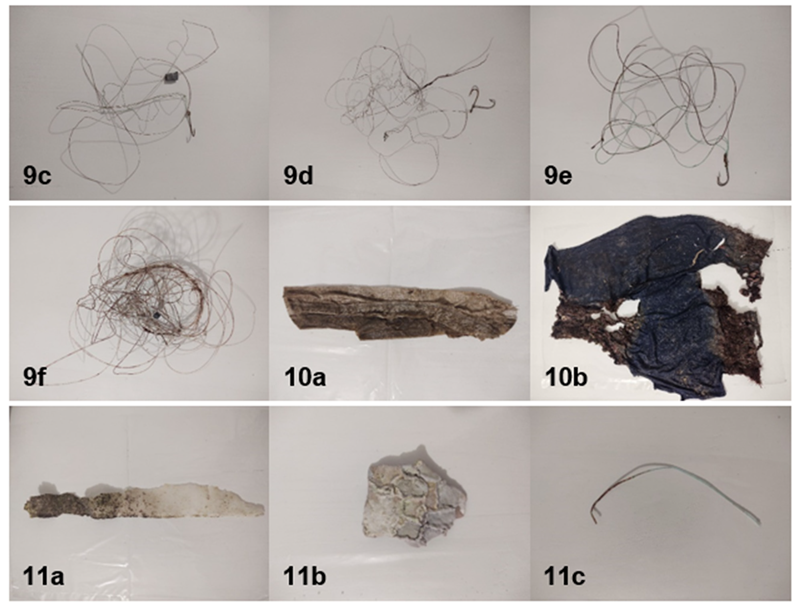
References
- Plastics Europe. Plastics—The Facts; Plastics Europe: Bruselas, Bélgica, 2022. [Google Scholar]
- Bozhko, A. Remediation of Marine Plastic Waste. Bachelor’s Thesis, Arcada University of Applied Sciences, Helsinki, Finland, 2019. [Google Scholar]
- Lippiatt, S.; Opfer, S.; Arthur, C. Marine debris monitoring and assessment: Recommendations for Monitoring Debris Trends in the Marine Environment. NOAA Technical Memorandum NOS-OR&R-46. Feigenbaum M. Quantitative universality for a class of nonlinear transformations. J. Stat. Phys. 2013, 1978, 19–25. [Google Scholar]
- Campoy, P.; Beiras, R. Revisión: Efectos ecológicos de macro-, meso-y microplásticos. Environ. Monit. Assessment 2019, 189, 581. [Google Scholar]
- Morales-Jiménez, C. Fotografía Macroplástico, Image of own authorship. 2021.
- Ruiz-Reyes, C.I. Fotografías Mesoplástico y Microplástico, Image of own authorship. 2021.
- Celaya-Nogueras, C. Detección y Caracterización de Micro/Nano Plásticos en Productos de Higiene Personal. Universidad de Zaragoza, CIEN, 2020. Available online: https://zaguan.unizar.es/record/88805 (accessed on 17 March 2022).
- Richards, Z.T.; Beger, M. A quantification of the standing stock of macro-debris in Majuro lagoon and its effect on hard coral communities. Mar. Pollut. Bull. 2011, 62, 1693–1701. [Google Scholar] [CrossRef] [PubMed]
- Figueroa-Pico, J.; Mero-Del Valle, D.; Castillo-Ruperti, R.; Macías-Mayorga, D. Desechos marinos: Implicaciones para la conservación de arrecifes rocosos en Manabí, Ecuador (Costa del Pacífico Sur). Boletín Contam. Mar. 2016, 109, 7–13. [Google Scholar]
- Figueroa-Pico, J.; Tortosa, F.S.; Carpio, A.J. Coral fracture by derelict fishing gear affects the sustainability of the marginal reefs of Ecuador. Coral Reefs 2020, 39, 819–827. [Google Scholar] [CrossRef]
- Santodomingo, N.; Perry, C.; Waheed, Z.; bin Syed Hussein, M.A.; Rosedy, A.; Johnson, K.G. Contaminación por basura marina en los arrecifes de coral de Darvel Bay (East Sabah, Malasia). Boletín Contam. Mar. 2021, 173, 112998. [Google Scholar]
- Rivera-Garibay, O.O.; Álvarez-Filip, L.; Rivas, M.; Garelli-Ríos, O.; Pérez-Cervantes, E.; Estrada-Saldívar, N. Impacto de la Contaminación por Plástico en Áreas Naturales Protegidas Mexicanas; Greenpeace: Mexico City, Mexico, 2020. [Google Scholar]
- Secretaría de Turismo (SECTUR). Available online: http://www.veracruz.gob.mx/2021/11/26/Veracruz-esta-profesionalizado-en-turismo-visitantes-generan-derrama-de-2-mil-170-mdp-sectur/ (accessed on 25 May 2021).
- Administración del Sistema Portuaria Nacional Veracruz (ASIPONA Veracruz). Available online: https://www.puertodeveracruz.com.mx/wordpress/blog/movimiento-historico-del-puerto-de-veracruz (accessed on 25 May 2021).
- Ortiz-Lozano, L.; Colmenares-Campos, C.; Gutiérrez-Velázquez, A. Submerged Coral Reefs in the Veracruz Reef System, Mexico, and its implications for marine protected area management. Ocean Coast. Manag. 2018, 158, 11–23. [Google Scholar] [CrossRef]
- Fuentes, J.C.N.; Granados, P.A.; Martins, F.C. Coastal management in Mexico: Improvements after the marine and coastal policy publication. Ocean Coast. Manag. 2017, 137, 131–143. [Google Scholar] [CrossRef]
- Horta-Puga, G.; Morales-Aranda, A.A. Sistema Arrecifal Veracruzano, Condición Actual y Programa Permanente de Monitoreo: Segunda Etapa; Universidad Nacional Autónoma de México: Mexico City, Mexico, 2017. [Google Scholar]
- Lebreton, L.; Slat, B.; Ferrari, F.; Sainte-Rose, B.; Aitken, J.; Marthouse, R.; Hajbane, S.; Cunsolo, S.; Schwarz, A.; Levivier, A.; et al. Evidence that the Great Pacific Garbage Patch is rapidly accumulating plastic. Sci. Rep. 2018, 8, 4666. [Google Scholar] [CrossRef]
- Barboza, L.G.A.; Cózar, A.; Giménez, B.C.; Barros, T.L.; Kershaw, P.J.; Guilhermino, L. Macroplastics Pollution in the Marine Environment. In World Seas: An Environmental Evaluation; Sheppard, C.R.C., Ed.; Academic Press: Philadelphia, PA, USA, 2019; pp. 305–328. [Google Scholar] [CrossRef]
- Escobar, J. La Contaminación de los ríos y sus Efectos en las Áreas Costeras y el Mar. In División de Recursos Naturales e Infraestructura; 2002. Available online: https://hdl.handle.net/11362/6411 (accessed on 17 March 2022).
- NOM-001-SEMARNAT-96; Límites Máximos Permisibles de Contaminantes en las Descargas de Aguas Residuales en Aguas y Bienes Nacionales. Diario Oficial de la Federación: Mexico City, Mexico, 1997.
- Holdren, C.; Jones, W.; Taggart, J. Managing Lakes and Reservoirs; North American Lake Management Society and Terrene Institute, in Cooperation with the Office of Water Assessment and Watershed Protection Division U.S. Environmental Protection Agency (EPA): Madison, WI, USA, 2001; Volume 382, p. 12.
- Arreguín-Cortés, F.; Gómez-Balandra, A.; Izurieta-Dávila, J. Contaminación difusa. Tláloc 2000, 7, 8–10. [Google Scholar]
- Campbell, N.S.; Arcy, B.D.; Frost, A.; Novotny, V. Diffuse Pollution: An Introduction to the Problems and Solutions; IWA Publishing: Cornwall, UK, 2004; p. 322. [Google Scholar]
- United Nations Environment Programme (UNEP). From Pollution to Solution. A Global Assessment of Marine Litter and Plastic Pollution; UNEP: Nairobi, Kenia, 2021; p. 148. Available online: https://wedocs.unep.org/bitstream/handle/20.500.11822/36963/POLSOL.pdf (accessed on 24 April 2021).
- Chubarenko, I.; Bagaev, A.; Zobkov, M.; Esiukova, E. On some physical and dynamical properties of microplastic particles in marine environments. Mar. Pollut. Bull. 2016, 108, 105–112. [Google Scholar] [CrossRef] [PubMed]
- United Nations Environment Programme (UNEP). Marine Litter: A Global Challenge; UNEP: Nairobi, Kenya, 2009; p. 232. Available online: https://stg-wedocs.unep.org/bitstream/handle/20.500.11822/31632/MLAGC.pdf?sequence=1 (accessed on 6 February 2022).
- Gregory, M.R.; Andrady, A.L. Plásticos en el Medio Marino; Ambiente, P.Y.M., Ed.; Wiley: Nueva York, NY, USA, 2003; pp. 379–402. [Google Scholar]
- Kühn, S.; Bravo-Rebolledo, E.L.; Franeker, A.V. Efectos Nocivos de la Basura Sobre la Vida Marina; Basura Antropogénica Marina: Santiago, Chile, 2015; pp. 75–116. [Google Scholar]
- Rochman, C.M. The complex mixture, fate and toxicity of chemicals associated with plastic debris in the marine environment. In Marine Anthropogenic Litter; Springer: Cham, Switzerland, 2015; pp. 117–140. [Google Scholar]
- Green, D.S.; Boots, B.; Blockley, D.J.; Rocha, C.; Thompson, R. Impacts of discarded plastic bags on marine assemblages and ecosystem functioning. Environ. Sci. Technol. 2015, 49, 5380–5389. [Google Scholar] [CrossRef] [PubMed]
- Smolowitz, R.J.; Corps, L.N.; Center, N.F. Lobster, Homarus americanus, trap design and ghost fishing. Mar. Fish. Rev. 1978, 40, 2–8. [Google Scholar]
- Macfadyen, G.; Huntington, T.; Cappell, R. Abandoned, Lost or Otherwise Discarded Fishing Gear; Food and Agriculture Organization of the United Nations (FAO): Rome, Italy, 2009. [Google Scholar]
- Moore, C.J. Synthetic polymers in the marine environment: A rapidly increasing, long-term threat. Environ. Res. 2008, 108, 131–139. [Google Scholar] [CrossRef] [PubMed]
- Allsopp, M.; Pambuccian, S.E.; Johnston, P.; Santillo, D. State of the World’s Oceans; Springer Science & Business Media: Berlin, Germany, 2008. [Google Scholar]
- Acampora, H.; Berrow, S.; Newton, S.; O’Connor, I. Presence of plastic litter in pellets from Great Cormorant (Phalacrocorax carbo) in Ireland. Mar. Pollut. Bull. 2017, 117, 512–514. [Google Scholar] [CrossRef] [PubMed]
- Nicolau, L.; Marçalo, A.; Ferreira, M.; Sá, S.; Vingada, J.; Eira, C. Ingestion of marine litter by loggerhead sea turtles, Caretta Vigoda, in Portuguese continental waters. Mar. Pollut. Bull. 2016, 103, 179–185. [Google Scholar] [CrossRef] [PubMed]
- Carpenter, E.J.; Smith, K. Plastics on the Sargasso Sea surface. Science 1972, 175, 1240–1241. [Google Scholar] [CrossRef]
- Andrady, A.L. Microplastics in the marine environment. Mar. Pollut. Bull. 2011, 62, 1596–1605. [Google Scholar] [CrossRef]
- Bakir, A.; Rowland, S.J.; Thompson, R.C. Enhanced desorption of persistent organic pollutants from microplastics under simulated physiological conditions. Environ. Pollut. 2014, 185, 16–23. [Google Scholar] [CrossRef]
- Andrady, A.L. The plastic in microplastics: A review. Mar. Pollut. Bull. 2017, 119, 12–22. [Google Scholar] [CrossRef]
- Ríos, L.M.; Moore, C.; Jones, P.R. Persistent organic pollutants carried by synthetic polymersin the ocean environment. Mar. Pollut. Bull. 2007, 54, 1230–1237. [Google Scholar] [CrossRef] [PubMed]
- Diario Oficial de la Federación (DOF). Ley General de Equilibrio Ecológico y la Protección al Ambiente; DOF: Mexico City, Mexico, 2014.
- Secretaría de Medio Ambiente y Recursos Naturales (SEMARNAT). Minimización y Manejo Ambiental de los Residuos Sólidos; Secretaría de Medio Ambiente y Recursos Naturales (SEMARNAT): Mexico City, Mexico, 2001; p. 228. [Google Scholar]
- Diario Oficial de la Federación (DOF). Reglamento De La Ley General Del Equilibrio Ecológico y La Protección Al Ambiente En Materia De Evaluación Del Impacto Ambiental; Diario Oficial de la Federación (DOF): Mexico City, Mexico, 2000.
- Secretaría de Medio Ambiente y Recursos Naturales (SEMARNAT). Proyecto De Norma Oficial Mexicana NOM-083-SEMARNAT-2003, Especificaciones De Protección Ambiental Para La Selección Del Sitio, Diseño, Construcción, Operación, Monitoreo, Clausura Y Obras Complementarias De Un Sitio De Disposición Final De Residuos Sólidos Municipales; Secretaría de Medio Ambiente y Recursos Naturales (SEMARNAT): Mexico City, Mexico, 2003. [Google Scholar]
- González, M.; Monreal, R. Senado de la República. Available online: http://infosen.senado.gob.mx/sgsp/gaceta/64/1/2019-04-101/assets/documentos/Inic_MORENA_residuos.pdf (accessed on 24 April 2019).
- Elvira, J. Secretaría de Medio Ambiente y Recursos Naturales. In Norma Oficial Mexicana: NOM-083-SEMARNAT-2003; Diario Oficial de la Federación (DOF): Mexico City, Mexico, 2004. [Google Scholar]
- Liaño-Carrera, F.; Camarena-Luhrs, T.; Gómez-Barrero, A.; Martos-Fernández, F.J.; Ramírez-Macias, J.I.; Salas-Monreal, D. Nuevas estructuras de arrecifes de coral en un sistema de arrecifes de coral tropical. Rev. Latinoam. Investig. Acuáticas 2019, 47, 270–281. [Google Scholar]
- Comisión de Áreas Naturales Protegidas (CONANP). Estudio Previo Justificativo para la Modificación de la Declaratoria del Parque Nacional Sistema Arrecifal Veracruzano; Comisión de Áreas Naturales Protegidas (CONANP): Veracruz, México, 2011; p. 87. [Google Scholar]
- Riverón-Enzástiga, M.; Carbajal, N.; Salas-Monreal, D. Tropical coral reef system hydrodynamics in the western Gulf of Mexico. Sci. Mar. 2016, 80, 237–246. [Google Scholar]
- Salas-Monreal, D.; Monreal-Jimenez, R.; Contreras-Tereza, V.K.; Monreal-Gomez, M.A.; Salas-de-Leon, D.A.; Riveron-Enzastiga, M.L. Hydrographic variation in a tropical coral reef system: The Veracruz Reef System, Gulf of Mexico. Oceanologia 2022, 64, 473–488. [Google Scholar] [CrossRef]
- Kjerfve, B. Water exchange across the reef crest at Carrie Bow Cay, Belize. Atlantic Barrier Reef Ecosyst. Carrie Bow Cay Belize 1982, 1, 59–63. [Google Scholar]
- Heery, E.C.; Hoeksema, B.W.; Browne, N.K.; Reimer, J.D.; Ang, P.O.; Huang, D.; Friess, D.A.; Chou, L.M.; Luke, L.H.L.; Saksena-Taylor, P.; et al. Arrecifes de coral urbanos: Degradación y resiliencia de conjuntos de corales duros en ciudades costeras del este y sureste de Asia. Contam. De Marzo. Toro. 2018, 135, 654–681. [Google Scholar] [CrossRef]
- Ryan, P.G. The transport and fate of marine plastics in South Africa and adjacent oceans. South Afr. J. Sci. 2020, 116, 1–9. [Google Scholar] [CrossRef]
- Gallo, F.; Fossi, C.; Weber, R.; Santillo, D.; Sousa, J.; Ingram, I.; Nadal, A.; Romano, D. Marine litter plastics and microplastics and their toxic chemicals components: The need for urgent preventive measures. Environ. Sci. Eur. 2018, 30, 1–14. [Google Scholar] [CrossRef]
- Derraik, J.G. The pollution of the marine environment by plastic debris: A review. Mar. Pollut. Bull. 2002, 44, 842–852. [Google Scholar] [CrossRef]
- Arroyo-Valverde, A. Análisis y estudio de las islas de basura oceánicas. In Trabajo Final de Grado; Facultad de Náutica de Barcelona, Universidad Politécnica de Cataluña: Barcelona, Spain, 2020. [Google Scholar]
- Ramalho, R.S. Tratamiento de Aguas Residuales. Reverté; Academic Press Inc.: Barcelona, España, 2021; ISBN 978-84-291-7975-5. [Google Scholar]
- Coe, J.M.; Rogers, D.B. Marine Debris: Sources, Impacts, and Solutions; Springer: New York, NY, USA, 1997. [Google Scholar] [CrossRef]
- Tunnell, J.W. Natural versus human impacts to southern Gulf of Mexico coral reef resources. In Proceedings of the 7th International Coral Reef Symposium, UOG Station, GU, USA, 22–27 June 1992; pp. 535–544. [Google Scholar]
- Jones, J.; Withers, K.; Tunnell, J.W., Jr. Comparison of benthic communities on six coral reefs in the Veracruz Reef System (Mexico). In Proceedings of the 11th International Coral Reef Symposium, Ft. Lauderdale, FL, USA, 7–11 July 2008. [Google Scholar]
- Ortíz-Lozano, L.D.; Granados-Barba, A.; Espejel, I. Ecosystemic zonification as a management tool for marine protected areas in the coastal zone: Applications for the Sistema Arrecifal Veracruzano National Park, Mexico. Ocean Coast. Manag. 2009, 52, 323. [Google Scholar] [CrossRef]
- Jiménez-Badillo, L.; Arenas-Fuentes, V.; Pérez-España, H. The Conservation–Exploitation Paradox in a Mexican Coral Reef Protected Area. Am. Fish. Soc. Symp. 2008, 49, 587–595. [Google Scholar]
- Comisión de Áreas Naturales Protegidas (CONANP). Bitácora de uso del PNSAV 2007-2010; Comisión de Áreas Naturales Protegidas (CONANP): Houston, TX, USA, 2010. [Google Scholar]
- Flores-Vargas, M. Ocurrencia y distribución de microplásticos en el Sistema Arrecifal Veracruzano, suroeste del golfo de México. Tesis de maestría. In Instituto de Ciencias Marinas y Pesquerías; Universidad Veracruzana: Veracruz, Mexico, 2022. [Google Scholar]
- Diario Oficial de la Federación (DOF). Acuerdo por el que se da a Conocer el Resumen del Programa de Manejo del Área Natural Protegida con Categoría de Parque Nacional la Zona Conocida como Sistema Arrecifal Veracruzano; CONANP: Mexico City, Mexico, 2017. [Google Scholar]
- Reyna-González, P.C. Modelo de Soporte para la Toma de Decisiones en el Parque Nacional Sistema Arrecifal Veracruzano; Universidad Veracruzana: Veracruz, Mexico, 2014. [Google Scholar]
- Gesamp, G. Guidelines for the Monitoring and Assessment of Plastic Litter in the Ocean. GESAMP Rep. Stud. 2019, 99, 130. [Google Scholar]
- Silva-Rodríguez, F.; Sanz-Aragonés, J.E. Tema 11. Los plásticos. Tecnología industrial I (1ª edición). In McGraw-Hill/Interamericana de España, S.A.U.; Aravaca: Madrid, España, 1997; pp. 164–174. ISBN 84-481-0444-7. [Google Scholar]
- Nicholson, J.W. The Chemistry of Polymers, 3rd ed.; RSC Paperbacks: Washington, DC, USA, 2006; ISBN 978-0-85404-684-3. [Google Scholar]
- International Agency for Reserch on Cancer (IARC). Vinyl chloride. Monographs. Available online: https://monographs.iarc.who.int/wp-content/uploads/2018/06/mono100F-31.pdf (accessed on 1 November 2018).
- Webb, H.K.; Arnott, J.; Crawford, R.J.; Ivanova, E.P. Degradación de plásticos y sus implicaciones ambientales con especial referencia al tereftalato de polietileno. Polímeros 2012, 5, 1–18. [Google Scholar]
- Wright, S.L.; Thompson, R.C.; Galloway, T.S. The physical impacts of microplastics on marine organisms: A review. Environ. Pollut. 2013, 178, 483–492. [Google Scholar] [CrossRef]
- Muthukumar, T.; Aravinthan, A.; Lakshmi, K.; Venkatesan, R.; Vedaprakash, L.; Doble, M. Fouling and stability of polymers and composites in marine environment. Int. Biodeterior. Biodegrad. 2011, 65, 276–284. [Google Scholar] [CrossRef]
- Avio, C.G.; Gorbi, S.; Regoli, F. Plastics and microplastics in the oceans: From emerging pollutants to emerged threat. Mar. Environ. Res. 2017, 128, 2–11. [Google Scholar] [CrossRef]
- Oliveira-Castro, O.; Lopes-da Silva, M.; Marques, M.R.; Vieira-de Araújo, F. Evaluación espacio-temporal de macro, meso y microplásticos en aguas superficiales, sedimentos de fondo y playa de dos ensenadas en Niterói, RJ, Brasil. Boletín Contam. Mar. 2020, 160, 111537. [Google Scholar]
- Artham, T.; Sudhakar, M.; Venkatesan, R.; Nair, C.M.; Murty, K.V.G.K.; Doble, M. Biofouling and stability of synthetic polymers in sea water. Int. Biodeterior. Biodegrad. 2009, 63, 884–890. [Google Scholar] [CrossRef]
- Bravo, M.; Astudillo, J.C.; Lancellotti, D.; Luna-Jorquera, G.; Valdivia, N.; Thiel, M. Rafting on abiotic substrata: Properties of floating items and their influence on community succession. Mar. Ecol. Prog. Ser. 2011, 439, 17. [Google Scholar] [CrossRef]
- Beaumont, N.J.; Aanesen, M.; Austen, M.C.; Börger, T.; Clark, J.R.; Cole, M.; Wyles, K.J. Global ecological, social, and economic impacts of marine plastic. Mar. Pollut. Bull. Núm. 2019, 142, 189–195. [Google Scholar] [CrossRef]
- Secretaría de Medio Ambiente y Recursos Naturales (SEMARNAT). Available online: https://www.gob.mx/semarnat/articulos/fuentes-de-contaminacion-atmosferica (accessed on 26 May 2022).
- López-Hernández, A.A. Análisis de la Presencia de Residuos Sólidos Plásticos en las Playas Turísticas de Veracruz. Master’s Thesis, Instituto Tecnológico de Boca del Río, Boca del Río, Mexico, 2018. [Google Scholar]
Disclaimer/Publisher’s Note: The statements, opinions and data contained in all publications are solely those of the individual author(s) and contributor(s) and not of MDPI and/or the editor(s). MDPI and/or the editor(s) disclaim responsibility for any injury to people or property resulting from any ideas, methods, instructions or products referred to in the content. |
© 2023 by the authors. Licensee MDPI, Basel, Switzerland. This article is an open access article distributed under the terms and conditions of the Creative Commons Attribution (CC BY) license (https://creativecommons.org/licenses/by/4.0/).